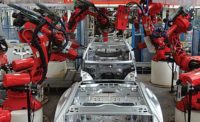Valkyrie is one of the newest “kids” on campus at Boston’s Northeastern University. She stands 6 feet 2 inches tall, weighs 285 pounds and dreams about exploring Mars someday.
However, Valkyrie isn’t a student. She’s an advanced humanoid robot that resides at the school’s Robotics and Intelligent Vehicles Research Laboratory (RIVeR). The organization is working with NASA to improve Valkyrie, with the goal of sending the robot to Mars.
RIVeR was founded in 2010 to create adaptive, robust everyday robots to empower humans in all aspects of life. The R&D effort focuses on the modeling and control of robot systems, and creating human-in-the-loop robot controls.
“We work on assistive robots to help individuals with disabilities and the elderly; humanoids for disaster response and space exploration; and technologies for advanced response to epidemics,” says Taskin Padir, Ph.D., associate professor of electrical and computer engineering and director of RIVeR. “We primarily focus on humanoid robots for space, nuclear waste cleanup, disaster relief and humanitarian aid.
“We also develop mobile manipulators for elder care and autonomous rovers for exploration,” adds Padir. “Our main research focus is on modeling, control and supervised autonomy.”
Padir and his colleagues have worked on projects such as intelligent prosthetics, smart wheelchairs, emergency personnel localization and personal assistant robots for elder care, as well as an intelligent underwater vehicle for search and rescue operations. They’re currently developing a robot for the U.S. Department of Energy that can perform dexterous manipulation tasks inside a nuclear power plant.
According to Padir, there are numerous challenges to working with and controlling autonomous robots. “This is primarily due to the dynamic nature of the systems, humans and places,” he points out.
“For example, you can program a smart wheelchair to work at a specific home for an individual with a specific disability,” explains Padir. “But, not every person with the same disability is the same, nor a person with a disability the same form day to day. This makes it challenging for robots to perform the same task in various environments. That’s why we focus on adaptability, personalization and validation in realistic situations.”
The goal of the Valkyrie project is to create a humanoid robot capable of helping to maintain and create necessities before and after astronauts arrive on Mars.
“Valkyrie is cutting-edge technology when it comes to humanoid robots,” claims Padir. “It has been designed by NASA’s Johnson Space Center, keeping modularity and precision in mind. The robot has dexterous hands, powerful actuators and a rich sensor suite. This allows us to work on what our lab is good at developing: algorithms for human-supervised control and autonomy.”
In addition to space exploration, Padir says there are many down-to-earth applications for robots such as Valkyrie. “Humanoid robots will be game-changing technology in healthcare, manufacturing, logistics and emergency response applications,” he points out.
“We are at the early stages of research in this field,” says Padir. “But, as we continue to advance the capabilities of these systems, they will take on tasks that are dangerous and challenging for humans, such as nuclear waste cleanup and infectious disease control.
“When the technology is mature enough, robots like Valkyrie will also be part of manufacturing environments,” adds Padir. “[Within 10 years], there will be a paradigm shift as intelligent robots safely collaborate with human workers to increase efficiency, safety and productivity.
“The development of collaborative robots will empower U.S. manufacturers to lead globally through innovation and the development of a brand new skilled workforce,” predicts Padir. “Autonomous robots will become a [valuable] asset.”
To see a video of Valkyrie in action, click here.


